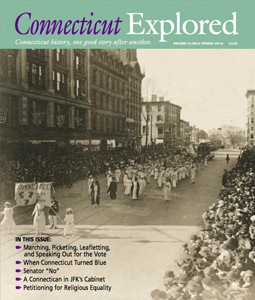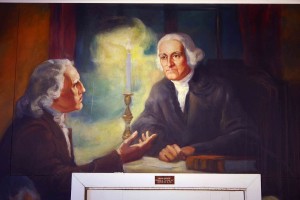by Walter W. Woodward
 (c) Connecticut Explored Inc. Spring 2016
(c) Connecticut Explored Inc. Spring 2016
It had been a terrible winter. Jedediah Strong, clerk of the Connecticut General Assembly, called it “the severest hard winter within the memory of man,” marked by an “abundance of snow and frequent storms,” and “the extreme degrees and long continuance of the cold.” The awful winter had been followed by “the most backward spring.” Farmers were far too late getting into their fields at a time when Connecticut soldiers were starving to death in Washington’s army, fighting a war that was not going well. The preceding summer Norwalk, Fairfield, and New Haven had been attacked and burned by the British. A terrible American defeat had been suffered at Savannah in October, and Charleston, under siege for months, was expected to surrender at any moment. May 1780 found Connecticans cold, hungry, and anxious—anxious about the weather; anxious about the war; anxious about the meaning of all this misfortune. No one was prepared for what happened on the morning of May 19.
At 9 a.m., the legislature was in session, trying to work through the maze of problems caused by “the horrors of an unnatural war,” as clerk Strong put it, when the sky began to darken. Within an hour, he wrote, it “occasioned a solemn gloom of unusual darkness.” In the lower house, work stopped as nervous legislators went to the windows to watch and wonder. It got darker still, and by 11 a.m. it was impossible to read or recognize another person’s features, even when they stood near the legislative chamber’s windows. Panic set in—both in the town and in the general assembly. Fearing that the day of divine Judgment—the Biblically prophesied moment when God would come to “judge the living and the dead – had actually arrived, the lower house hastily adjourned, legislators groping their way through the darkness toward home.
Up in the Council of Safety (the upper house whose members were charged with managing Connecticut’s day-to-day response to the war), a cooler head prevailed. Judge Abraham Davenport of Stamford called his fellows to their civic duty, even in the face of impending doom. “The day of judgment is coming or it is not,” Davenport told his fellow councilors. “If it is not, there is no occasion for alarm. If it is, I wish to be found in the line of my duty. I move therefore, that candles be brought.” Davenport and company stayed at work throughout what is still known as New England’s Dark Day. By 2 p.m., the darkness had dissipated, and a sheepish legislature returned to join Davenport in doing its duty.
Scientists believe the cause of the sudden darkness on May 19, 1780 was smoke from a huge Canadian forest

Delos Palmer, “Dark Day” mural, detail, 1934, Stamford Town Hall. Courtesy Stamford Historical Society
fire that blew eastward and temporarily blocked the sun throughout New England. But for Puritan Yankees with little understanding of science, and a long tradition of seeing God’s hand in all events, the Day of Darkness was a test of duty that one man passed with flying colors.
Walter W. Woodward is the Connecticut state historian.
Read More
Read more about Connecticans exercising their civic duty in the Spring 2016 issue.
